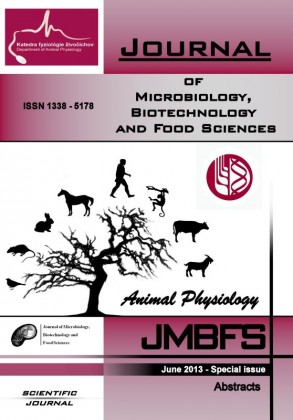EFFECT OF DIFFERENT CONCENTRATION OF CAFFEINE ON TURKEY SPERMATOZOA MOTILITY IN IN VITRO CONDITIONS AT 41°C
Keywords:
caffeine, turkey, spermatozoa, motility, CASAAbstract
The target of this study was to evaluate the turkey spermatozoa motility in in vitro conditions and to prove the effect of various caffeine concentrations (diluted in physiological solution): 5 mg.ml-1 – A; 2.5 mg.ml-1 – B; 1.25 mg.ml-1 – C; 0.625 mg.ml-1 – D at various time periods at 41°C. Individual motility parameters were recorded at four time periods: 0, 60, 120 and 180 minutes. Semen samples of adult male turkeys of the line Big 6 were diluted a ratio of 1 part of semen and 200 parts of physiological solution (control sample) and with different concentrations of caffeine (experimental groups). Measurements were evaluated by the CASA system (Computer Assisted Semen Analyser).At the beginning of cultivation significantly lower values of spermatozoa motility were detected only in the sample D (p<0.05). Significantly higher values (p<0.001) of this parameter were observed after 60 minutes of cultivation in the samples A, B and the sample D comparing with control. The A sample showed significantly higher values (p<0.05) also at time 120. Spermatozoa progressive motility followed the tendency of spermatozoa motility. Significantly higher data were observed in samples A (p<0.01), B (p<0.05) and the sample D (p<0.01) compared the control after 60 minutes of culture. Non-significant differences were found in all experimental samples in other time of in vitro cultivation. Results of our study detected positive effect of caffeine on the turkey spermatozoa motility cultured at 41°C.
Downloads
Download data is not yet available.
Downloads
Published
2013-06-06
How to Cite
Slanina, T., Slyšková, L., & Massányi, P. (2013). EFFECT OF DIFFERENT CONCENTRATION OF CAFFEINE ON TURKEY SPERMATOZOA MOTILITY IN IN VITRO CONDITIONS AT 41°C. Journal of Microbiology, Biotechnology and Food Sciences, 2(Abstracts special issue), 9. Retrieved from https://office2.jmbfs.org/index.php/JMBFS/article/view/7529
Issue
Section
Biotechnology
License
Copyright (c) 2013 Tomáš Slanina, Lucia Slyšková, Peter Massányi

This work is licensed under a Creative Commons Attribution 4.0 International License.
All papers published in the Journal of Microbiology, Biotechnology and Food Sciences are published under a CC-BY licence (CC-BY 4.0). Published materials can be shared (copy and redistribute the material in any medium or format) and adapted (remix, transform, and build upon the material for any purpose, even commercially) with specifying the author(s).

